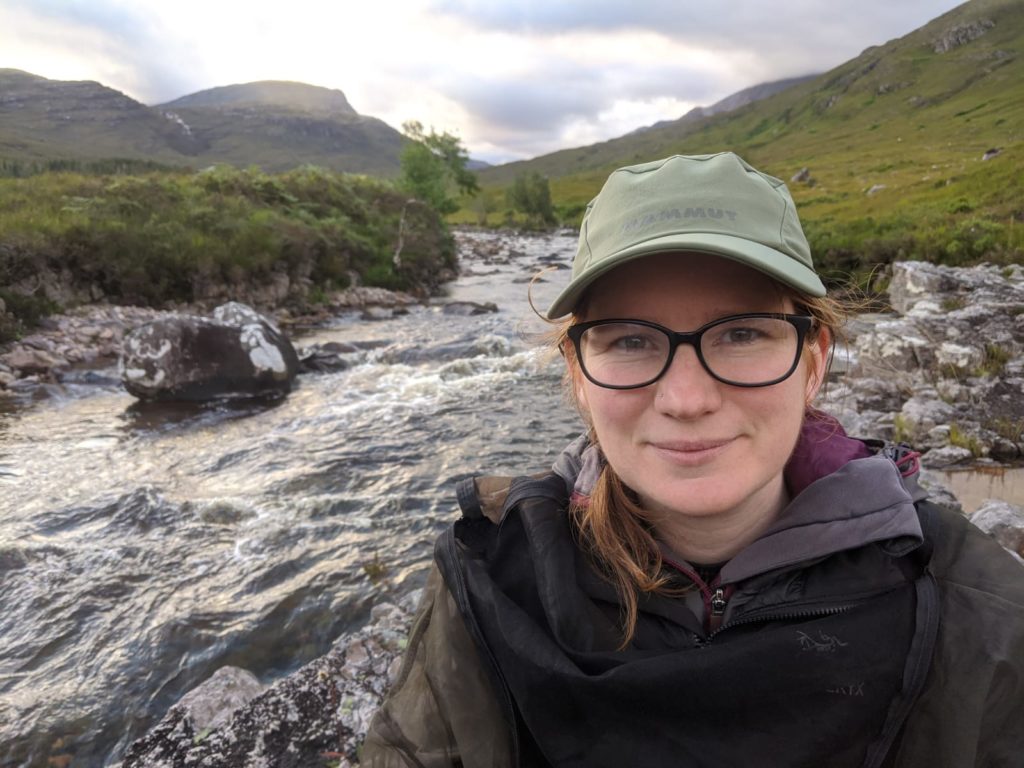Ensuring the long-term survival of highly threatened species, in Scotland and around the globe.
“What gets me out of bed in the morning is the feeling that I am able to make a tangible difference to the recovery of threatened species. I am Head of Conservation and Science Programmes at the Royal Zoological Society of Scotland (RZSS) and I currently oversee a wonderful team of over 20 conservation practitioners and scientists who together, with our many partners, are working on the recovery of 30 different species in Scotland and around the world. Our wildlife conservation charity‘s ambition is to have assisted with the recovery of 50 species by 2030.
“Nowadays I would describe myself as an evolutionary biologist turned conservation geneticist turned conservation manager. I studied at Environmental and Evolutionary Biology at the University of St Andrews, then did my PhD in the Institute of Evolutionary Biology at the University of Edinburgh. I started work in RZSS’s WildGenes lab – based at Edinburgh Zoo – 13 years ago. My first project was working on the genetic analysis of threatened antelope species. Today, this work is contributing to the active reintroduction of the scimitar-horned oryx, addax and dama gazelle to Chad. Before this work started, scimitar-horned oryx were extinct in the wild. Addax and dama gazelle today have tiny populations left (approximately 30-150) individuals. Ensuring that the founders of new wild populations have the highest levels of genetic diversity possible is critical to their long term survival – especially in the face of climate change and emergent diseases.
“I’ve spent the last decade supporting the reintroduction of beavers to Scotland, initially from a technical and then a managerial perspective. It’s been a real privilege to be part of this journey and it’s taught me a lot about the challenges of reintroductions – the use of science to support conservation, the absolute requirement for collaborative working, and the need for patience and commitment. Species recovery happens on ecological timeframes, not on timeframes that are convenient to people!

“It feels like we are in an exciting moment right now – we are actively working on the release back to the wild of native Scottish species including the wildcat, pine hoverfly and pond mud snail. Release projects are hugely interdisciplinary, and I love that. I see RZSS’s role being to help species where ecosystem restoration happening around them alone is not enough to secure their recovery, or where they can benefit from our specialist skills. These are: genetic management, veterinary science, animal care and planning conservation interventions.
“We currently have some really exciting projects transferring these skills internationally. In Cambodia, we are working closely with the Royal University of Phnom Penh and Fauna & Flora International to establish genetic methods to manage the reintroduction programme of the critically endangered Siamese crocodile. The situation of the Siamese crocodile is very similar to the Scottish wildcat (they both hybridise with other species and are both reliant on conservation breeding) and I find that we translate a huge amount of learning between international projects. The zoo community has always had a global focus, and that brings a lot to our work here in Scotland.
“I am really hoping that the Post-2020 Global Biodiversity Framework, which COP15 aims to finalise, will contain ambitious targets for species recovery, and will recognise the critical role of ex-situ conservation and genetic management for species on the brink of extinction. For me, the acid test of healthy ecosystems is if they can support species that have wide-ranging and complex needs, such as wildcats, golden eagles, salmon and pine hoverfly.
“Species are going extinct at 100 times the natural background rate and have been dramatically impacted by habitat loss and overexploitation, while climate change is impacting the very makeup of ecosystems in future. We have already lost so many species – and vast amounts of genetic variation within species that are not yet extinct. This is so apparent when I look at the DNA of the species that we study and compare contemporary populations with historical samples collected from museum specimens. It is critical that we retain as much biodiversity of species and genes in the processes of ecosystem restoration as possible, if we want to weather the biodiversity crisis.”
Dr Helen Senn is Head of Conservation and Science Programmes at the Royal Zoological Society of Scotland. RZSS is a wildlife conservation charity registered in Scotland (SC004064). Find out more here.
This post is part of a series showcasing Scotland’s innovative, high-impact research supporting biodiversity conservation, in partnership with Scottish Government and NatureScot. Read the rest of the series here.
Further reading
Senn, H.V., et al. 2014. Splitting or lumping? a conservation dilemma exemplified by the critically endangered dama gazelle (Nanger dama). PLoS One 9(6): e98693. https://doi.org/10.1371/journal.pone.0098693
Senn, H.V., et al. 2014. Nuclear and mitochondrial genetic structure in the Eurasian beaver (Castor fiber) – implications for future reintroductions. Evolutionary Applications 7(6): 645—662. https://doi.org/10.1111/eva.12162
Shafer, A.B.A., et al. 2015. Genomics and the challenging translation into conservation practice. Trends in Ecology and Evolution 30(2): 78—87. https://doi.org/10.1016/j.tree.2014.11.009
Senn, H.V., et al. 2018. Distinguishing the victim from the threat: SNP-based methods reveal the extent of introgressive hybridization between wildcats and domestic cats in Scotland and inform future in situ and ex situ management options for species restoration. Evolutionary Applications 12(3): 399-414. https://doi.org/10.1111/eva.12720
Howard‐McCombe, J., et al. 2021. On the use of genome‐wide data to model and date the time of anthropogenic hybridisation: An example from the Scottish wildcat. Molecular Ecology 30(15): 3688—3702. https://doi.org/10.1111/mec.16000
Krofel, M., et al. 2022. Towards resolving taxonomic uncertainties in wolf, dog and jackal lineages of Africa, Eurasia and Australasia. Journal of Zoology 316(3): 155—168. https://doi.org/10.1111/jzo.12946
